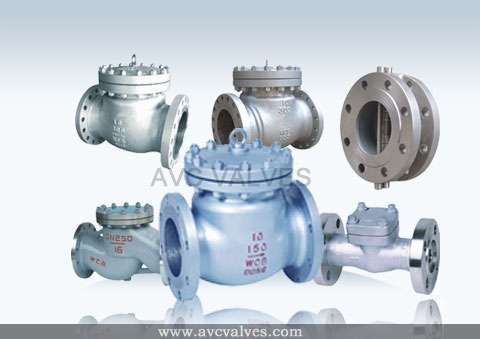
Check Valve
AVC Check valves are self-activating safety valves that permit gases and liquids to flow in only one direction, preventing process flow from reversing. They are classified as one-way directional valves. Fluid flow in the desired direction opens the valve, while backflow forces the valve closed. The mechanics of check valve operation are relatively simple. Most check valves contain a ball that sits freely above the seat, which has only one through-hole. The ball has a slightly larger diameter than that of the through-hole. When the pressure behind the seat exceeds that above the ball, liquid is allowed to flow through the valve; however, once the pressure above the ball exceeds the pressure below the seat, the ball returns to rest in the seat, forming a seal that prevents backflow.
Check valves use a variety of technologies to allow and stop the flow of liquids and gases. Single-disc swing valves are designed with the closure element attached to the top of the cap. Double-disc or wafer check-valves consist of two half-circle disks hinged together that fold together upon positive flow and retract to a full-circle to close against reverse flow. Lift-check valves feature a guided disc. Spring-loaded devices can be mounted vertically or horizontally. Silent or center guide valves are similar to lift check valves, with a center guide extending from inlet to outlet ports. The valve stopper is spring and bushing actuated to keep the movement "quiet.” Ball check valves use a free-floating or spring loaded ball resting in a seat ring as the closure element. Cone check valves use a free-floating or spring loaded cone resting in the seat ring as the closure element. Selecting check valves requires an analysis of performance specifications, materials of construction, connection types, and media. Performance specifications include valve size, pressure rating, media temperature, and valve flow coefficient. Most check valves are made of acetal polymers, aluminum, brass, bronze, cast iron, chlorinated polyvinyl chloride (CPC), ductile iron, copper, polyethylene (PE), polypropylene (PP), polytetrafluoroethylene (PTFE), polyvinyl chloride (PVC), polyvinylidene fluoride (PVDF), rubber, steel, or stainless steel. Connections for check valves can use threads, compression fittings, tube fittings, bolt flanges, clamp flanges, butt welds, socket welds, and union connections. In terms of media, check valves are rated for air, compressed air, water, hot water, cold water, potable water, salt water, wastewater, gasoline, diesel fuel, high-purity gas, liquefied petroleum gas (LPG), natural gas, sour gas, corrosive gas, abrasive material, acids, corrosive chemicals, adhesives, concrete, grout, coolants, hazardous materials, high-viscosity fluids, hydraulic fluids, liquid metal, lubricants, oil, powders, solids, rendering wastes, sludge, slurry, ash slurry, or steam. AVC Valve specializes in the design and production of a wide range of gate valves, such as Cast iron Check valve,Ductile iron Check valve,Cast steel Check valve,Stainless steel Check valve,Forged steel Check valve ,Wafer type Check valve and so on . All of AVC Valves' Check valves are designed,manufactured and tested to API,ASME,ANSI,JJS,DIN and BS standards. |

